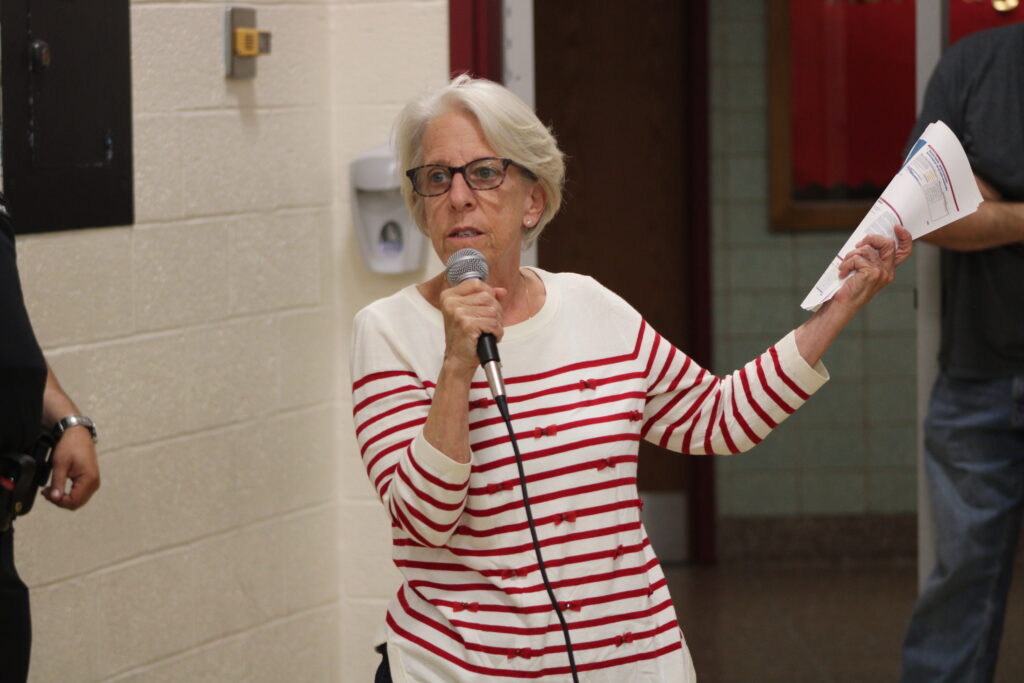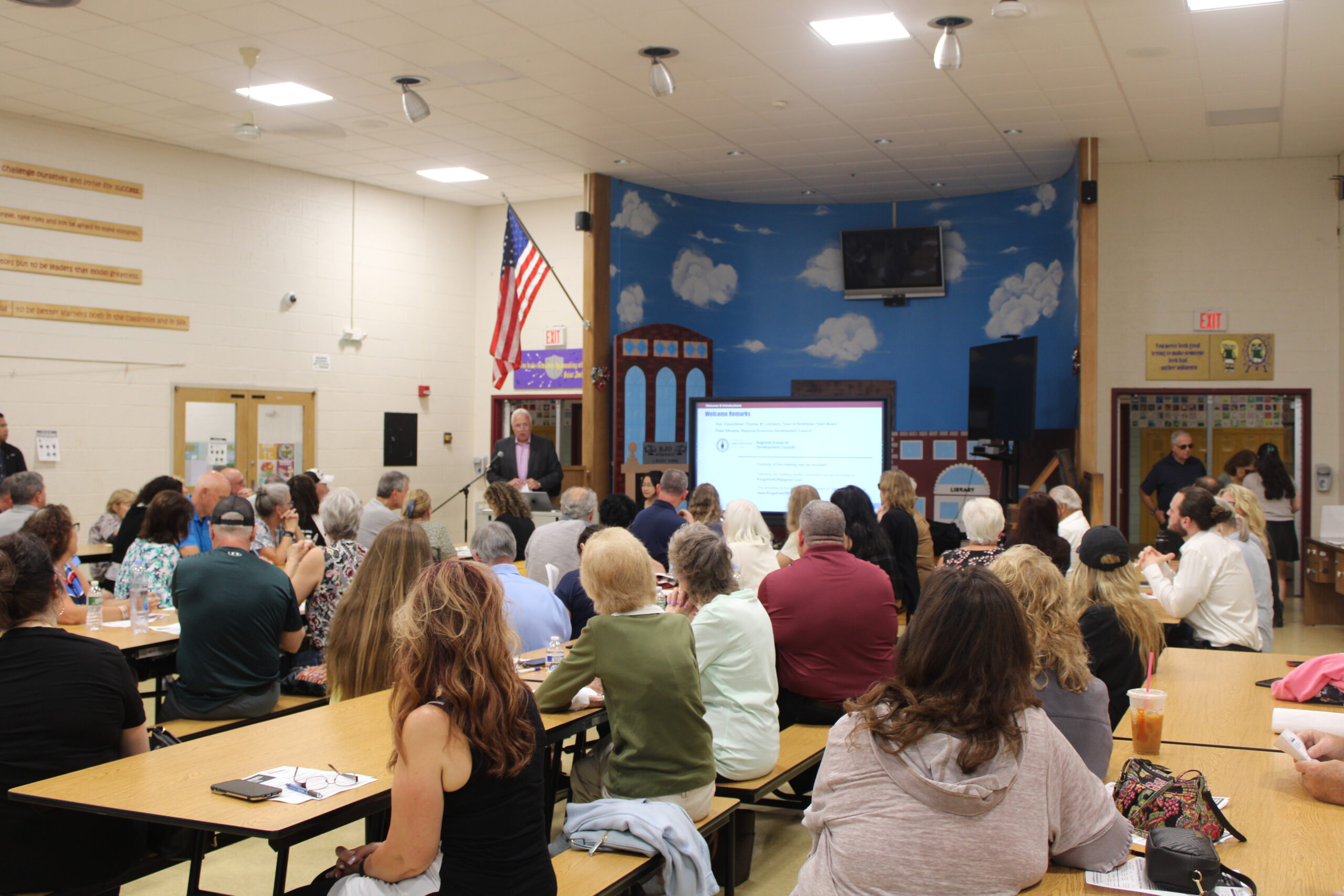(Pictured above) Residents gather for the first meeting on the Kings Park DRI Grant (Credit – Matt Meduri)
In January, Governor Kathy Hochul (D) visited Kings Park to deliver a prestigious $10 million grant for Kings Park’s Downtown Revitalization Initiative (DRI). Long a priority of the Town Board, downtowns across the Town of Smithtown have received a series of upgrades and facelifts, including, but not limited to, sewer projects, streetscaping, beautification, and main street enhancements. St. James, Smithtown hamlet, and Kings Park have gotten the most attention, but Kings Park’s historic, quaint personality is set to receive additional improvements from the State grant.
A competitive grant process, Kings Park was just one of several localities within the entire State that received such funds in the latest round of grants.
Now, the process turns over to a series of public meetings, wherein the Kings Park community can voice their concerns, desires, and ideas as to how the grant money should be spent within the hamlet.
The first meeting was held last Thursday evening at the R.J.O Intermediate School on Old Dock Road.
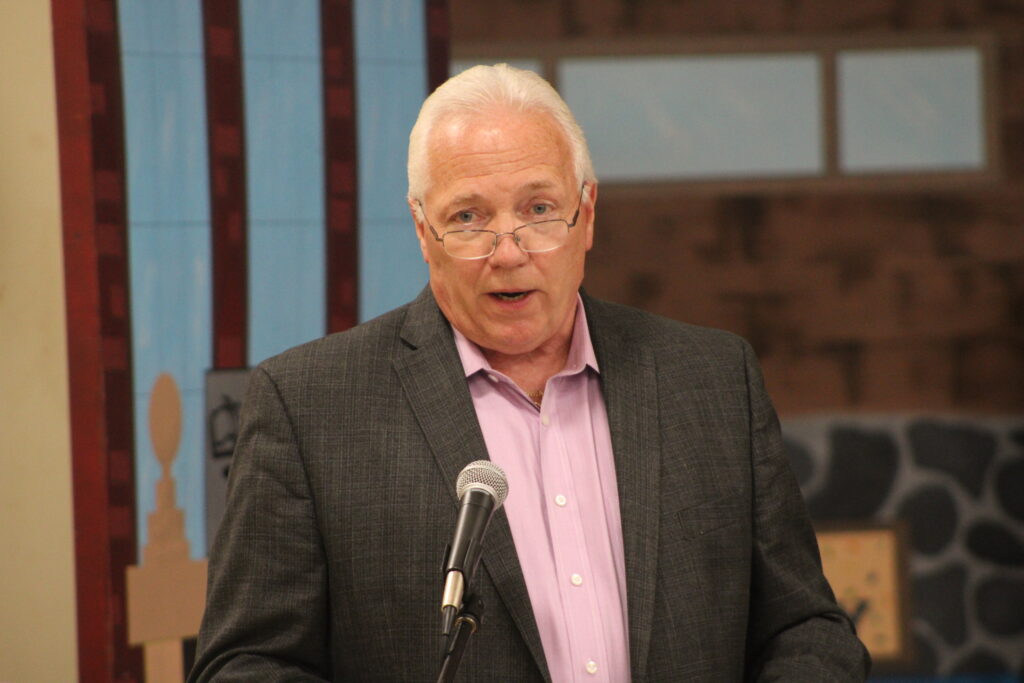
“This was our fifth run of trying to secure this grant,” said Councilman Tom Lohmann (R-Smithtown) (pictured above) in opening remarks. “Your tax money that goes to other places is back here in Kings Park where it belongs.”
The Town and community are being guided through the process by the State’s prize consultants for the Long Island region. The consultants have guided other communities through similar DRI grant projects before. The local planning committee is made up of community members, who also hold public meetings for the purpose of the grant.
The DRI, which is in its seventh overall year, assigns grants to municipalities in the ten economic regions of New York. In the Long Island region, previous recipients have been Westbury, Hicksville, Central Islip, Baldwin, Amityville, Riverhead, and Huntington Station.
Edward Lamson, Principal and Co-Director of Urban Planning at BJH, the State’s consultants, ran the presentation and informed the attendees on how the DRI works and what to expect throughout the course of the process as it pertains to Kings Park.
“The DRI program has a series of statewide goals for each community to aspire to,” said Lamson. “To create active downtowns with a strong sense of place to attract new businesses, enhance public spaces for arts and cultural events, to build a diverse population to complement housing and employment opportunities, to grow the local tax base, to provide amenities that support quality of life, and to reduce greenhouse gas emissions.”
Lamson used the Westbury project as an example of what the DRI grant could implement through public input. Westbury saw transit-oriented development (TOD) near the LIRR station, new pedestrian and sidewalk upgrades along the main street, and a small project plan to improve businesses, facades, and revenues.
Lamson also said that after a six-month period of public input, the consultancy firm and the local planning committee will evaluate the project proposals and make the recommendations to the State. The State then makes determinations based on those proposals.
“These [community] goals and vision statements will be used to evaluate the project,” said Lamson. “A lot of planning has been done to date in this community, and that’s also one of the reasons why this community was awarded the funds. You have a master plan, and we want to build on that momentum. At the very end of this, our goal is to ensure that many voices are heard and perspectives are heard about these projects and that proposed projects are carefully considered and vetted by both the town and the committee.”
Lamson said that property owners, homeowners, business owners, and residents alike can suggest project ideas for consideration. Lamson used an example from the Huntington Station project, in which a member of the public proposed new pathways from the sidewalk to the LIRR station. The Town adopted the idea and it was funded through the State DRI grant.
However, Lamson mentioned that not every proposal will make it into the final plan.
“The local planning committee must discuss – and these meetings are all public – and decide on the final list of projects to recommend. That’s part of the process, and that’s why we have five public meetings,” said Lamson.
Lamson stressed that the purpose of Thursday’s meeting was to begin collecting public input, deem which projects are eligible or ineligible for funding, and escalate those projects to the various boards and committees involved. Lamson said that projects submitted must be “ready to be implemented in the near future, are transformational, and feasible, meaning that they are projects of public support and they can fit within the town’s approval process.”
The four main categories of funding are all capital improvements or investments. The first category is public improvement projects, which includes street improvements, main street enhancements, parks, and public art.
The second category pertains to new development or rehabilitation of downtown buildings. This can include proposals like mixed-use commercial or residential developments.
The third category involves small project grants, including facade improvements, small-scale renovations, or business assistance.
The fourth and final category of funding concerns branding and marketing. This includes signage, wayfinding, marketing services for the area, or branding service for the Chamber of Commerce.
The DRI does not fund stand-alone planning activities, operations and maintenance, pre-award costs, property acquisition, training or program expenses, social programs, or public safety, nor does it replace existing resources.
A project must break ground within two years of receiving DRI funding.
The event was then open to public input and questions from residents.
One resident voiced his concerns on the state of the roads and the dangers they pose to pedestrians, to which Lamson said that while the Town has identified sites for streetscape improvements, the scope of their assessment is not necessarily final. Lamson asked for project submissions that pertain to traffic-calming measures, pedestrian crossings, or other safety features of the roadways.
Another resident mentioned visible, disorganized electrical wires, suggesting they be put underground.
A longtime Kings Park resident asked if the existing sewer projects would be able to handle possible development projects included in the DRI grant. Lamson said that much of that depends on public input, as well as an Environmental Impact Statement (EIS), as well parameters set by Suffolk County.
The same resident also asked where the acceptance rate of proposed projects stands in relation to other Long Island communities. Lamson said that the Huntington project received twenty project requests, which would have cost $20 million. The list was then narrowed down to what would fit into the predetermined $9.7 million grant from the State.
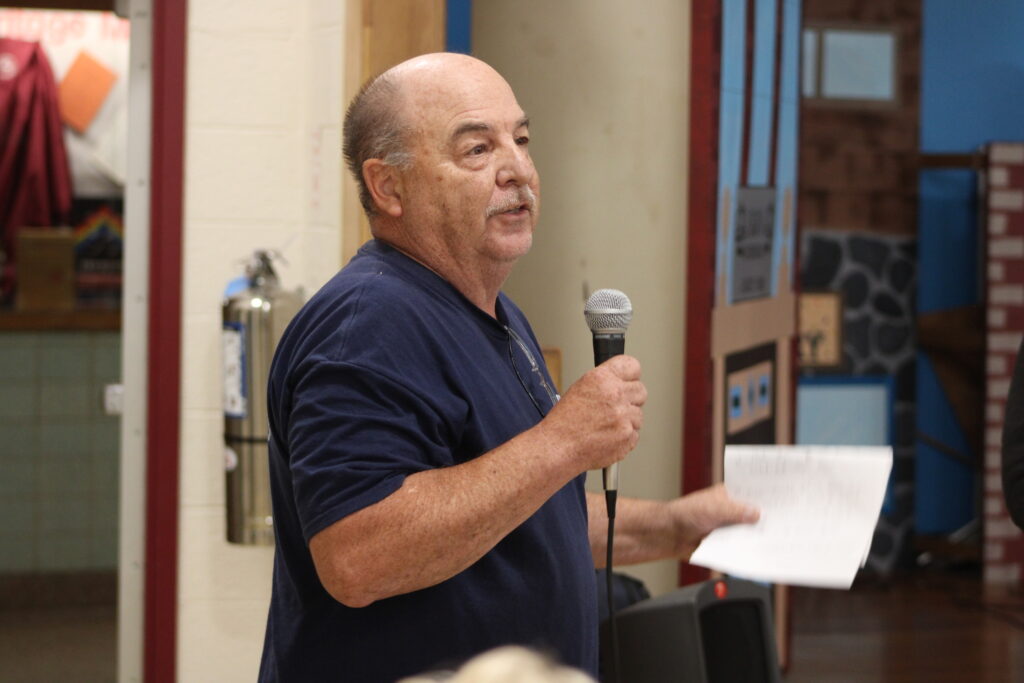
Bill Pawlirzyn (pictured above), a Kings Park resident, cautioned the audience against overdevelopment, stating that “transformation” means “change our town.”
“They want to diversify our population because they’re not happy with our current population,” said Pawlirzyn.
Kim Francisci asked about strains on services if development becomes part of the DRI plan. She compared Kings Park to nearby Northport, an incorporated village that has its own public safety. Francisci lamented slow response times from SCPD, as well as a twenty-minute ambulance response time for a recent car accident.
Francisci also asked about the code of conduct for committee members who submit projects of their own. Lamson said that committee members will not be involved in the deliberation of a project he or she has submitted. A committee member will not even be allowed in the room to discuss the project he or she has suggested.
Heather Speciale brought up the problem of absentee landlords, asking how the DRI consultants and committee will be able to mitigate the threat of an out-of-state landlord looking to cash in on the DRI grant funding in Kings Park.
“We are leaning towards the community to avoid these concerns,” said Lamson. “I think part of it is trying to get those absentee landlords to invest in these properties. If they’re not in the community, this is one way to get them.”
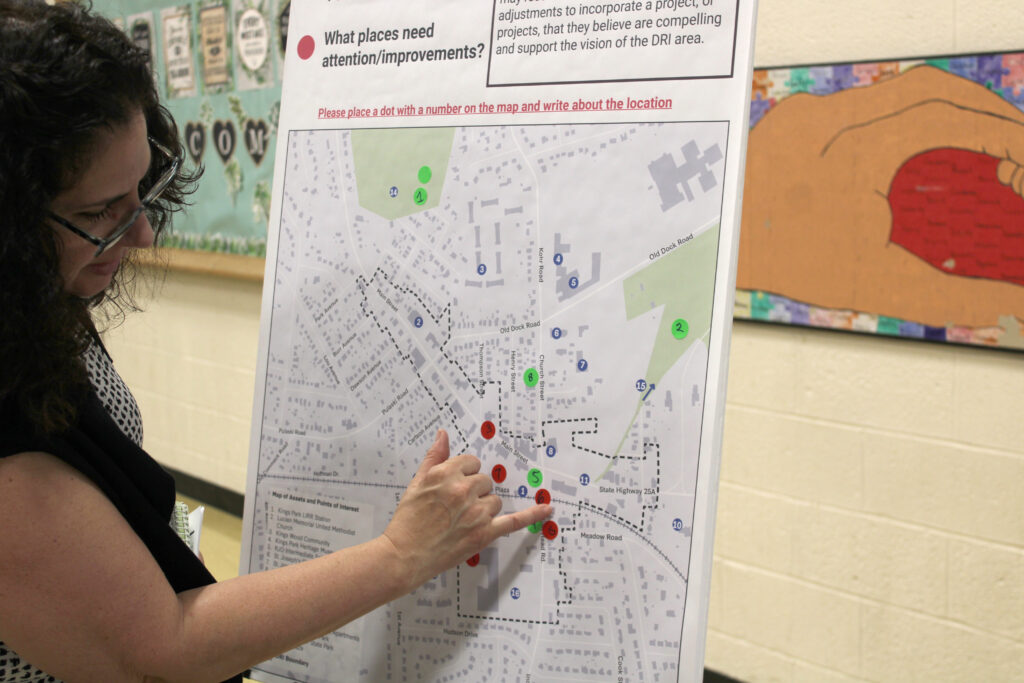
Attendees were then able to consult numerous easels with renderings of Kings Park, as well as sticky notes to include their suggestions and visions for the future of the area (pictured above).
“I believe at the end of the day, Kings Park is going to see a really nice product,” Smithtown Supervisor Ed Wehrheim (R-Kings Park) told The Messenger.
As a Kings Park resident himself, Wehrheim answered what he would like to see for the future of his community.
“I want to see beautiful streetscapes, which we have additional funding above the
$9.7 million we’re getting from the State. That’s put away, so we’re going to plan nice streetscapes,” said Wehrheim. “Running electric underground is a good proposal, but we have to look at pricing on that. We tried that for the Lake Avenue [St. James] project, but PSE&G said it’s about $6 million per mile. King Park’s main street is a little less than a mile, but it’s something we’ll look at.”
Wehrheim added that he would like to see a “walkable” community with improved restaurants – a feasible plan with extended sewer capacities.
“Kings Park is centrally located,” said Wehrheim, referencing the numerous parks and beaches nearby, as well as the LIRR station in the heart of town. “It’s about bringing people into Kings Park to make the businesses profitable and raise property values.”
Apart from the DRI grant initiatives, Wehrheim said that the Town is currently looking at the vacant lot on the corner of Thompson Street and Main Street, a parcel he says would be “prime real estate” for central parking, perhaps with a small pocket park in the middle of the business district.
Suffolk County Legislator Rob Trotta (R-Fort Salonga) also attended the meeting, agreeing with the proposal that the electric wires should be buried along Main Street, as well as stressing “pride in ownership” as it relates to development.
“I’m not for these apartments. People didn’t move to Kings Park for apartments. I think a small number would okay, but I don’t think fifty of them on a quarter, half, or eighth of an acre is appropriate,” Trotta told The Messenger. “Half of them should be condos; we are robbing a generation of building equity. If you’re renting an apartment for $3,000 a month, you’re not saving any money. Developers want recurring revenue; they want to build and collect forever. If they want to do that, go to Queens.”
The application for project ideas is live at kingsparkdri.com/documents. Meeting slides and recordings can also be found at the link. Project works are due Friday, July 19, by 5:00 p.m. Late and incomplete project submissions will be accepted at the discretion of the local
planning committee.
